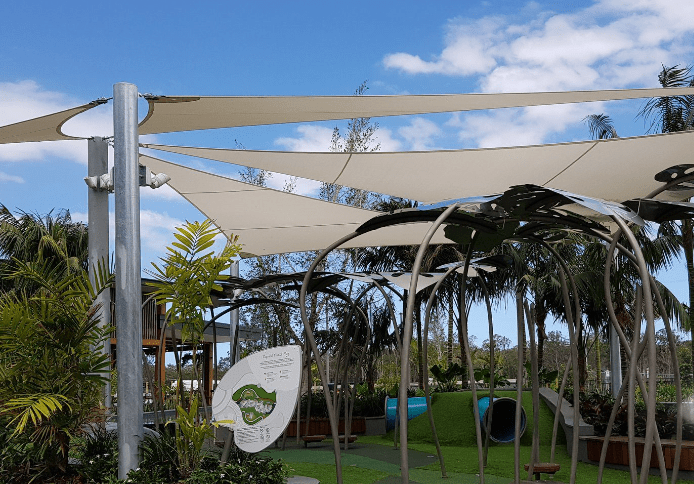When it comes to creating inviting, functional outdoor spaces in Brisbane, shade structures play a vital role. Whether it’s a park, playground, community space, or outdoor seating area, effective shade solutions can enhance usability and protect visitors from the harsh Australian sun. However, choosing the right shade structure for public spaces involves more than just aesthetics. Durability, wind resistance, and UV protection are key considerations, especially in Brisbane’s unique climate.
In this guide, we’ll explore everything you need to know about selecting durable shade structures for public spaces in Brisbane, helping councils, businesses, and public entities make informed decisions.
- Understanding the Brisbane Climate
Brisbane’s subtropical climate presents both opportunities and challenges for outdoor spaces. The city experiences warm, humid summers and mild winters, with significant rainfall during the summer months. This climate means outdoor spaces are used year-round, but it also exposes shade structures to intense sunlight, high UV radiation, and the occasional strong winds and storms.
This climate demands shade structures that can withstand a range of environmental factors:
- UV radiation: Brisbane has some of the highest UV levels in the world, making sun protection essential.
- Wind resistance: Summer storms can bring strong winds that can compromise the integrity of poorly designed structures.
- Heat reduction: The right shade structure can significantly reduce the temperature beneath it, making outdoor spaces more comfortable for public use.
Choosing materials and designs that account for these factors will ensure the longevity and safety of your shade structures.
- Key Considerations for Durability
Durability should be a primary concern for councils and businesses investing in shade structures for public spaces. The following are essential factors to consider:
a. Material Quality
The materials used in a shade structure determine its durability and ability to withstand Brisbane’s elements. Here are the most common options:
- Polycarbonate or steel roofing: For more permanent, solid shade solutions, polycarbonate and steel roofs offer high durability, especially in areas exposed to heavy rainfall or intense sun. These materials are particularly suited for bus shelters, walkways, or community centre shading.
- Timber: While timber can provide a natural, aesthetic appeal, it requires regular maintenance to prevent weathering in outdoor settings. Engineered timber with weather-resistant coatings can improve its longevity.
- Metal: Steel or aluminium frameworks offer robust support for both fabric and solid-roof shade structures. Powder-coated or galvanized metal resists corrosion, making it ideal for Brisbane’s humidity and coastal areas.
- Fabric (shade sails): High-density polyethylene (HDPE) is a popular material for shade sails due to its UV resistance, durability, and breathability. Ensure the fabric is rated for UV protection, with some fabrics offering up to 98% UV block out. Quality fabrics can also reduce the heat beneath the structure, improving comfort for users.
b. Structural Design for Wind Resistance
Wind resistance is crucial when selecting shade structures for Brisbane’s public spaces. Shade sails, for example, can act like sails in high winds, making it essential that they are properly tensioned and securely anchored.
- Fixed-roof structures: For areas exposed to high winds, such as coastal regions or open parks, fixed-roof structures like those made from polycarbonate or steel are a better option. These structures are designed to resist wind uplift and ensure stability even in severe weather.
- Tensioned structures: Properly tensioned shade sails, which are anchored at multiple points, can withstand strong winds if designed correctly. The tensioning process ensures the fabric doesn’t flap or tear in windy conditions, which prolongs its lifespan.
c. UV and Weather Resistance
UV degradation can weaken fabrics and materials over time. Ensure the shade structure’s components are treated for UV resistance, particularly the fabric. Many high-quality shade sails come with UV-resistant coatings, while metal structures often feature UV-stabilized paints or finishes to prevent deterioration.
Similarly, weather resistance is essential to prevent rust, fading, and material weakening. Galvanized or powder-coated steel frameworks, for example, resist rust and corrosion, making them ideal for Brisbane’s humid and coastal environments.
d. Maintenance Requirements
Public shade structures should be low-maintenance, as constant repairs can increase costs over time. Opt-in for materials and designs that require minimal upkeep, such as corrosion-resistant metals or fabrics that can be easily cleaned. While timber structures may require more frequent sealing or painting, many synthetic and metal options are virtually maintenance-free.
- Types of Shade Structures for Public Spaces
Understanding the different types of shade structures available is essential when choosing the right solution for your public space. Here are some common options:
a. Shade Sails
Shade sails are one of the most popular options for Brisbane’s public spaces due to their versatility and aesthetic appeal. These fabric structures can be customized to fit various shapes and sizes, making them ideal for playgrounds, parks, and seating areas.
Shade sails can be tensioned between multiple anchor points, allowing for flexibility in design. Their UV-blocking fabrics offer excellent sun protection, and their open design allows for good airflow, reducing the heat beneath.
b. Cantilever Structures
Cantilever shade structures feature a single support column with an extended arm that holds up the shading material. This design allows for more unobstructed space beneath the shade, making it ideal for areas like car parks, bus stops, and seating areas where minimal posts are desired.
Cantilever structures are highly durable, with sturdy steel frames and a variety of roofing materials, including fabric, polycarbonate, or metal.
c. Retractable Canopies
For businesses or public spaces requiring flexible shading, retractable canopies offer the perfect solution. These systems allow the canopy to be extended or retracted as needed, providing shade during the hottest parts of the day while allowing sunlight in cooler weather.
Retractable canopies are excellent for outdoor dining areas, rooftop bars, or multi-use public spaces where varying light levels are desirable.
d. Fixed-Roof Structures
For areas that require permanent shading solutions, such as walkways, bus shelters, or large community spaces, fixed-roof structures made from polycarbonate, steel, or even green roofing systems (which incorporate plants) are ideal. These structures are highly durable, offering long-term protection against sun, rain, and wind.
- Customizing Shade Structures for Public Spaces
Customization is key when installing shade structures in public spaces, as each area has unique requirements. Here are some customization options to consider:
- Shape and size: Shade sails offer flexible design options, allowing you to cover odd-shaped areas or provide coverage where traditional roofing might not be feasible.
- Colours: Shade sails and fabrics come in a variety of colours, allowing councils and businesses to match the structure to their branding or the surrounding environment.
- Additional features: Some shade structures can incorporate lighting, gutters for water management, or even solar panels to create sustainable public spaces.
- Award-Winning Installations in Brisbane
Highlighting successful projects can help demonstrate the value of durable shade structures. For example, an award-winning shade company in Brisbane might showcase installations in local parks, playgrounds, or commercial areas that have withstood harsh weather while providing aesthetic and functional benefits. Such case studies not only show the quality of work but also inspire other councils and businesses to invest in similar solutions.
Conclusion
Selecting the right shade structure for public spaces in Brisbane involves careful consideration of material quality, wind resistance, UV protection, and maintenance requirements. By choosing durable materials and designs that are suited to Brisbane’s climate, councils and businesses can create long-lasting, safe, and attractive outdoor spaces that benefit the community year-round.
Investing in a high-quality, well-designed shade structure is not just about providing protection from the sun; it’s about enhancing the usability and appeal of public spaces while ensuring they stand the test of time.

